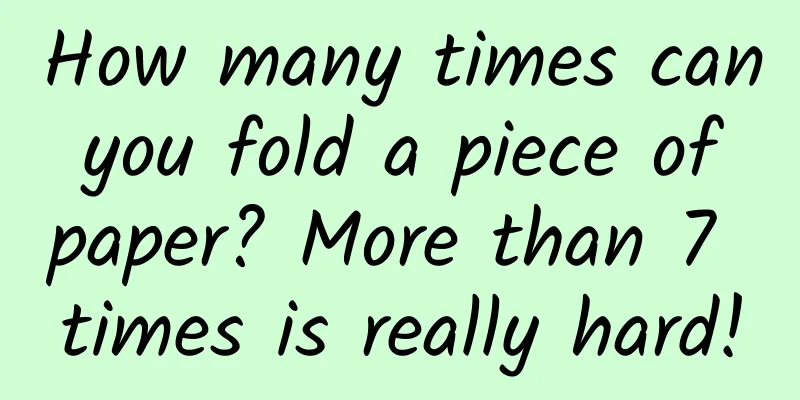How many times can you fold a piece of paper? More than 7 times is really hard!

|
We have been dealing with paper for many years and have folded countless pieces of paper, and we can even fold them into various shapes. But have you ever tried another origami challenge? Take a piece of ordinary A4 paper, fold it in half, and then fold it in half again. How many times do you think you can fold it in half at most? Blind guess: Folding it a dozen times shouldn’t be a problem, right? However, when you try it, you will find: A4 paper folded 7 times | Photo provided by the author It is actually difficult to fold an ordinary A4 paper more than 7 times! Is 7 times really the upper limit of the origami challenge? Can this limit be broken? In fact, this is a simple math problem. 01Mathematical description of origami Assuming that the original length, width, and thickness of the paper are a, b, and t respectively, after being folded n times, the changes in the three dimensions are shown in the following table. The relationship between the number of times an A4 paper is folded and the paper size | Image provided by the author As can be seen in the table, each time it is folded, the length or width is halved, while the thickness doubles. There is a 2^n power relationship between them, which means that the size relationship changes very quickly. Many stories involve 2^n power relationships. For example, the salary problem: you are given 1 point on the first day, and it doubles every day from the second day. After a month, the total salary will exceed 10 million yuan. Another example is the king's chessboard rice problem: there is 1 grain of rice in the first square, and each subsequent square doubles. When 64 squares are placed, the entire kingdom and even the entire world will be hollowed out. The relationship between the multiplication of rice grains on a chessboard | Photo provided by the author Back to the origami problem, when folded n times, the thickness of the paper becomes 2^n times the original thickness. An A4 paper is about 0.1 mm thick. If it is folded 23 times, its thickness will reach about 839 meters , while the tallest building on earth, the Burj Khalifa, is only 828 meters high. The tallest building in the world | Source: Photo Network When folded 42 times, the thickness of the paper will reach 439,805 kilometers, which is more than the average distance between the Earth and the Moon (384,403.9 kilometers). If folded 58 times, the thickness will exceed the diameter of the solar system (about 30 billion kilometers); folded 83 times, it will be able to break out of the Milky Way (about 160,000 light years in diameter). Maybe one day we can reach the sun and land on Mars by origami😜A small A4 paper can look down on the universe in mathematics. If we continue to fold it in this way, there will be no need for Chang'e 6. However, such an obvious bug will naturally be restricted by the "rules of the universe", which are mechanics and materials. 02 The cosmic rules of origami - mechanics and materials In reality, an ordinary A4 paper can usually only be folded in half 7 times. After folding in half 7 times, the theoretical size of the paper becomes: Length: 18.6 mm Width: 26.3 mm Thickness: 12.8 mm At this point, the thickness is the smallest, and it doesn't seem difficult to fold it in half again. But after folding it in half again, the thickness increases to 25.6mm, which is much larger than the length and width. It is easy to understand why it is not easy to bend at this time. However, in fact, the "rules of the universe" intervened earlier. After folding it in half 7 times, the appearance of the entire origami looks very "twisted", with warps in many places, and the gaps between the layers of paper have also become larger. At this time, it becomes very difficult to fold it in half for the 8th time. How can this be explained? Reason 1: The Rule of Force As the number of origami increases, the size of the paper becomes smaller and smaller, but the thickness becomes larger and larger. From a mechanical point of view, the smaller the size and the thicker the object, the greater the force required to bend it. On the one hand, the reduction in size reduces the bending moment generated by the force, and more force is required to bend the paper. On the other hand, the increase in thickness makes the stacked paper more rigid and less likely to deform. Comparison of bending force | Photo provided by the author I is the moment of inertia, b is the section width, and h is the section height. Reason 2: Size rules Smart students may have discovered some clues: if the A4 paper becomes thinner, the folded paper will also be thinner. Then according to the law of force, the thinner folded paper has lower rigidity and is easier to bend. Indeed, if a thinner napkin is used, it is relatively easy to fold it 8 times. However, the thickness of paper cannot be infinitely thinned, so using a larger size of paper can also solve this problem. Unknowingly, origami has become a challenge. The earliest origami record was set in 2002, when a high school student named Britney Gallivan from California, USA , successfully folded a piece of paper 12 times in a row, setting a Guinness World Record . Source: Science Engineering Technology In 2012, students from St. Mark's High School in Texas, USA, folded a piece of paper over 4 kilometers long 13 times. Because the last fold used a lot of auxiliary equipment, this record was not recognized by Guinness. 13 unrecognized records | Source: Baijiahao The famous "MythBusters" team pieced the paper together into a large sheet of 55*75 meters, and with the help of a steamroller, they eventually folded it in half 11 times. The Mythbusters team completed 11 folds | Source: YouTube Reason 3: Structural rules When paper is folded in half and stacked together, it forms a structure similar to a laminate. When this structure is not bonded between layers, the inner layer remains almost unchanged while the outer layer is stretched. The thicker the paper, the greater the degree of stretching of the outer layer, so the greater the external force required. If the layers are completely independent and only rely on friction, it will not be enough to resist the bending force, and it is easy to cause interlayer slippage after bending. For intact paper, the folds are connected to each other. This connection force plus the friction between the layers makes it difficult for the layers to slide, and greater force is required to overcome the bending force. Even when the paper is thick enough, the pulling force of the outer layer of paper generated by bending will exceed its tensile limit, causing the paper to break and the challenge to fail. In addition, a single layer of ordinary A4 paper also has a certain structural strength, which is why softer napkins can be folded in half more times. If it is an equally soft thin silk, it can also be easily folded in half more than 7 times. Thin and soft silk is folded 8 times|Photo provided by the author The multiplication relationship of the number of folds may exceed your imagination. Folding less than 100 times can easily break through the Milky Way and look down on the universe. However, the rules of the universe limit the folding limit of A4 paper. As the number of folds increases, the required external force increases sharply due to the reduction of the force arm and the increase of the crease connection force. If you want to fold more times, you need thinner, softer, and larger flat materials. Hurry up and take out some paper and try folding it in half. If you work hard, you might become the new Guinness World Record holder for origami! Author: Wang Yongjian, Associate Professor of Nanjing Agricultural University, Deputy Secretary-General of the Science Popularization Committee of Jiangsu Mechanics Society, Chief Science and Technology Communication Expert of Jiangsu Province Planning & Editing: Little Dandelion Cover image source: TED-Ed |
<<: A "new" fish was discovered in the Yangtze River? Good news for the "old" fish as well →
Recommend
VIVO App Store Open Platform Application Review Specifications
Open platform application review specifications 1...
How to plan marketing activities for those festivals that are “difficult” to leverage?
Holiday marketing planning has obvious advantages...
Can controlled nuclear fusion become a reality?
We live in an era of technological explosion, wit...
Analysis of Himalaya's competitive products
Preface : From Himalaya , I have briefly analyzed...
Did you know that half of the products in supermarkets may contain palm oil?
Palm Oil in Everyday Life Palm oil is one of the ...
It turns out there are things that will make you uglier the more you eat!
One minute with the doctor, the postures are cons...
How exciting is the work of a forensic doctor? Besides corpses, what else do you study?
Expert of this article: Zhang Yinming, PhD in For...
China Automobile Dealers Association: China's passenger car sales in the first quarter of 2022 were 4.894 million, down 9.8% year-on-year
In the first quarter of 2022 , domestic passenger...
Everything grows on sunlight? Deep-sea creatures: Guess how I survived
As the saying goes, "everything grows with t...
Detailed explanation of Baidu’s bidding method!
What are the bidding methods of Baidu ? What do C...
A self-media from 0 to 1: How to operate a Toutiao account?
1. Have a clear and measurable goal We all like t...
Mobile QQ 8.1.8 is officially launched: no more worry about losing chat records
Recently, Tencent officially announced that mobil...
Tesla officially announced its plan to build a factory in Shanghai
Electric car manufacturer Tesla's plan to bui...
How does information flow advertising highlight selling points? Share 4 tips!
In daily advertising , do our designers and artis...
What work should be included in the bidding hosting service contract?
First of all, let me explain to you that a biddin...









